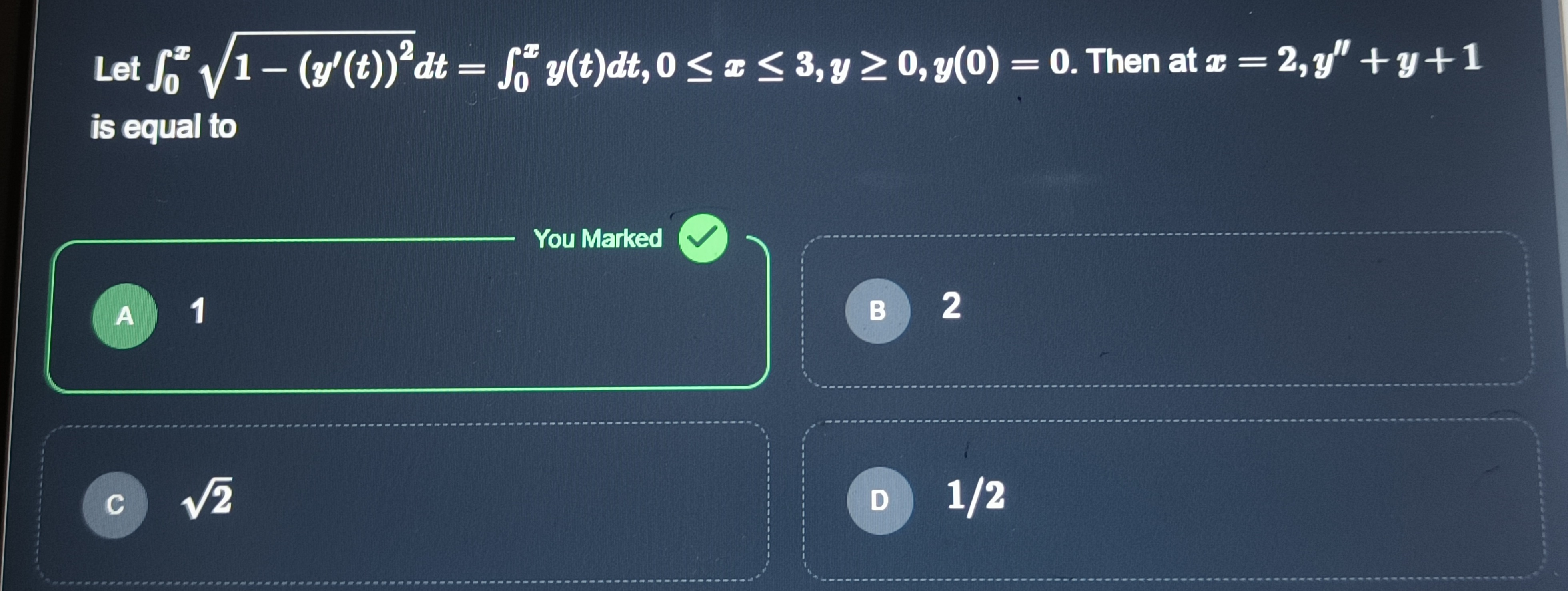Question
Question: Let $\int_0^x \sqrt{1-(y'(t))^2} dt = \int_0^x y(t) dt, 0 \leq x \leq 3, y \geq 0, y(0)=0$. Then at ...
Let ∫0x1−(y′(t))2dt=∫0xy(t)dt,0≤x≤3,y≥0,y(0)=0. Then at x=2,y′′+y+1 is equal to

1
Solution
Differentiating both sides of the given integral equation with respect to x using the Fundamental Theorem of Calculus, we get: 1−(y′(x))2=y(x) Since y(x)≥0, we can square both sides: 1−(y′(x))2=(y(x))2 Rearranging the terms, we obtain the differential equation: (y′(x))2+(y(x))2=1 Differentiating this equation with respect to x: 2y′(x)y′′(x)+2y(x)y′(x)=0 2y′(x)(y′′(x)+y(x))=0 This implies that for any x, either y′(x)=0 or y′′(x)+y(x)=0.
If y′(x)=0, then from (y′(x))2+(y(x))2=1, we have 02+(y(x))2=1, which means y(x)=±1. Since we are given y≥0, y(x)=1. In this case, y′′(x)=0. So, y′′(x)+y(x)+1=0+1+1=2.
If y′′(x)+y(x)=0, then the expression y′′(x)+y(x)+1 becomes 0+1=1.
To determine which case applies, we need to find the specific solution y(x). From 1−(y′(x))2=y(x), we have dxdy=±1−y2. If dxdy=1−y2, separating variables gives 1−y2dy=dx. Integrating yields arcsin(y)=x+C. Thus, y(x)=sin(x+C). Using y(0)=0, we get C=nπ. So y(x)=sin(x+nπ). For y≥0 on [0,3], we must have y(x)=sin(x) (when n is even). If dxdy=−1−y2, separating variables gives 1−y2dy=−dx. Integrating yields arcsin(y)=−x+C. Thus, y(x)=sin(C−x). Using y(0)=0, we get C=nπ. So y(x)=sin(nπ−x). For y≥0 on [0,3], we must have y(x)=sin(x) (when n is odd).
So, the unique solution is y(x)=sin(x). For y(x)=sin(x), we have y′(x)=cos(x) and y′′(x)=−sin(x). The expression y′′(x)+y(x)+1 becomes −sin(x)+sin(x)+1=1. This is consistent with the case where y′′(x)+y(x)=0. The case y′(x)=0 occurs when cos(x)=0, i.e., x=2π. At this point, y(2π)=sin(2π)=1. Here y′′(x)+y(x)+1=−1+1+1=1. Thus, for y(x)=sin(x), the expression y′′+y+1 is always equal to 1. Therefore, at x=2, y′′(2)+y(2)+1=1.
